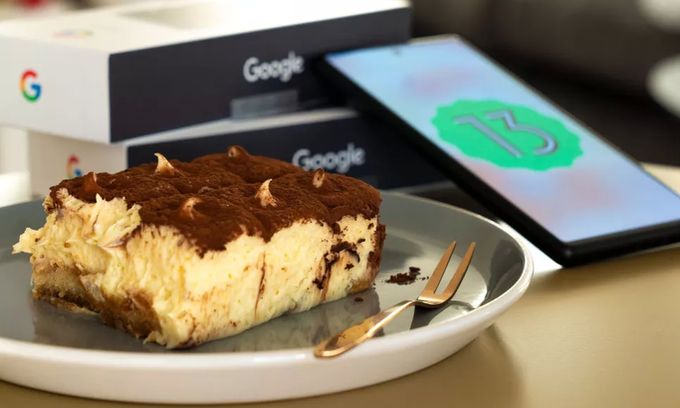Android version names are perfect for a ‘belly feast’ list. It already contains many tasty names:
– Android 1.5 – Cupcake;
– 1.6 – Donut;
– 2.0 – Eclair;
– 2.2 – Froyo;
– 2.3 – Gingerbread;
– 3.0 – Honeycomb;
– 4.0 – Ice Cream Sandwich;
– 4.1 – Jelly Bean;
– 4.4 – KitKat;
– 5.0 – Lollipop;
– 6.0 – Marshmallow;
– 7.0 – Nougat;
– 8.0 – Oreo;
– 9 – Pie;
– 10 – Queen Cake;
– 11 – Red Velvet Cake;
– 12 & 12.1 – Snow Cone.
Since Android 10 version, names officially only contain number. But ‘confectionery’ names still exist as internal codenames. In 2022 the global giant continues this tradition. Android 13 will be called Tiramisu (Italian: tiramisù [ˌtiramiˈsu], from tirami su, ‘pick me up’ or ‘cheer me up’). This is a coffee-flavoured Italian dessert of ladyfingers (savoiardi) dipped in coffee, layered with a whipped mixture of eggs, sugar, and mascarpone cheese, flavoured with cocoa.
Android 13
But, of course, the name is not the most important thing in the new version. It should solve more global problems.
In recent years, push messages after apps installation have created inconvenience for the user due to their huge number. Previously, Google tried to fix this problem by separating push messages between channels and providing an option to turn them off. But many users were not even aware of this feature or did not understand how to use it. After analyzing the situation, Google radically solved the problem. In the new version, push messages of all applications must have separate access from the user, which is confirmed in the POST_NOTIFICATIONS dialog.
According to Google, new requirement will work differently for Android 13 or for Android 12 and earlier. In particular, Android 13 users will be able to launch it at any time on their own initiative. In earlier versions, request to enable push notifications will only fire when creating a notification channel (first app launch).
The developers have also added a group of NEARBY_DEVICES permissions for applications that manage device connections to nearby WiFi hotspots. They can be used to organize the work of a smart home or to interact with nearby devices (transferring video in an app from a phone to a TV, etc.).
Google has also improved the reading of a certain type of files for pictures, video and audio. The previous version used a common permission for all files with READ_EXTERNAL_STORAGE. The Android 13 device will now use READ_MEDIA_IMAGES, READ_MEDIA_VIDEO or READ_MEDIA_AUDIO. Moreover, when requesting at the same time, for example, for READ_MEDIA_IMAGE and READ_MEDIA_VIDEO, the dialog asks for only one approve.
Main improvements
An added API (Application Programming Interface) provides ability to revoke permission with passing permission name into ‘revokeOwnPermissionOnKill()’, enhancing user privacy.
In the new version, the TARE (The Android Resource Economy) section has been added to the developer settings section. It provodes the energy management and works with AlarmManager and JobScheduler.
The feature introduces ‘Android Resource Credits’, which is an analog of currency. Its quantity depends on the battery level. To put it simply, depending on the battery charge level, the system will determine the amount of energy-credits for apps that will use them as ‘payments’ for the ability to perform tasks. In fact, taking into account the battery charge, the system will set limits on the tasks scheduled using the JobScheduler and AlarmManager.
For utility applications, the new version makes it easier to add an application card. In fact, option will allow the user to add it without leaving the app.
In addition, the developers have improved the selecting photos. New version improves security when selecting media files without giving the app access to the entire media library. By using
MediaStore.EXTRA_PICK_IMAGES_MAX.
val intent = Intent(MediaStore.ACTION_PICK_IMAGES)
the user can select one or more photos, and set their maximum number.
To create graphics, the company has added support for RuntimeShader programmable objects. This option will be useful, for example, for applying effects to complex graphics.
The updated back gesture will display the destination before the swipe is completed. Its operation is similar to scrolling up when returning to the home screen.
Conclusion
Google is currently testing Android 13 for mobile devices and tablets. As a beta version, the new platform is already available for Pixel owners. For owners of other models, Android 13 will be available after the end of testing, which is scheduled for August this year.
But the American corporation is also actively working on Android 14. This platform has already been created as an alpha version and has a compiled firmware. In keeping with tradition, the company plans to name it Upside Down Cake.
Such a cake is baked upside down in a special form. This recipe calls for placing fruit in the bottom of a pan and covering it with batter on top. Then, the form is placed in the oven and baked.
The beta-version of latest Android 14 will be available in early 2023, with a release expected in the second half of the year. According to preliminary data, the new OS will have an enhanced security system, enhanced functionality, an updated look and, similar to the iPhone and iPad (iOS), a full-fledged backup system for creating backups.
This video announces the main and new features of Android 13 Tiramisu.
